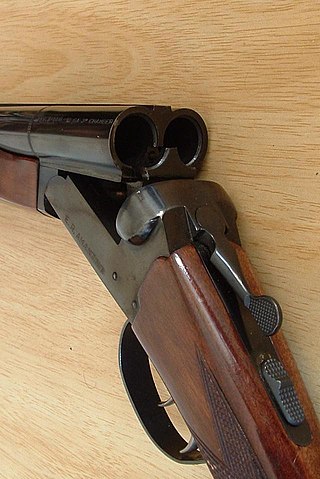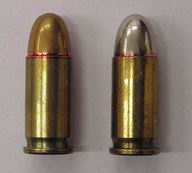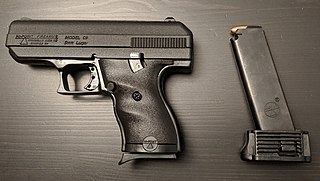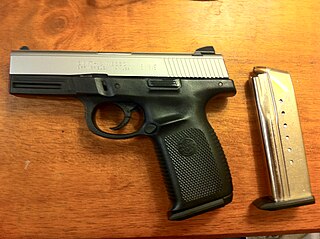
In firearms terminology, an action is the functional mechanism of a breech-loading firearm that handles the ammunition cartridges, or the method by which that mechanism works. Actions are technically not present on muzzleloaders, as all those are single-shot firearms with a closed off breech with the powder and projectile manually loaded from the muzzle. Instead, the muzzleloader ignition mechanism is referred to as the lock.

A semi-automatic pistol is a handgun that automatically ejects and loads cartridges in its chamber after every shot fired. Only one round of ammunition is fired each time the trigger is pulled, as the pistol's fire control group disconnects the trigger mechanism from the firing pin/striker until the trigger has been released and reset.

The .380 ACP, also known as .380 Auto, .380 Automatic, or 9×17mm, is a rimless, straight-walled pistol cartridge that was developed by firearms designer John Moses Browning. The cartridge headspaces on the mouth of the case. It was introduced in 1908 by Colt, for use in its new Colt Model 1903 Pocket Hammerless semi-automatic, and has been a popular self-defense cartridge ever since, seeing wide use in numerous handguns. Other names for .380 ACP include 9mm Browning, 9mm Corto, 9mm Kurz, 9mm Short, and 9mm Browning Court. It should not be confused with .38 ACP. The .380 ACP does not strictly conform to cartridge naming conventions, named after the diameter of the bullet, as the actual bullet diameter of the .380 ACP is .355 inches.

.32 ACP is a centerfire pistol cartridge. It is a semi-rimmed, straight-walled cartridge developed by firearms designer John Browning, initially for use in the FN M1900 semi-automatic pistol. It was introduced in 1899 by Fabrique Nationale, and is also known as the 7.65 mm Browning Short.
Blowback is a system of operation for self-loading firearms that obtains energy from the motion of the cartridge case as it is pushed to the rear by expanding gas created by the ignition of the propellant charge.

A breechblock is the part of the firearm action that closes the breech of a breech loading weapon before or at the moment of firing. It seals the breech and contains the pressure generated by the ignited propellant. Retracting the breechblock allows the chamber to be loaded with a cartridge.

The Thunder 380 is a lightweight, relatively small semi-automatic pistol series chambered in the .380 ACP caliber made by Argentine firearms manufacturer Bersa, S.A.

L. W. Seecamp Co. was an American manufacturer of pocket pistols located in Milford, Connecticut from 1981 to 2014. In 2014, Whalley Precision purchased the company and took over production of the pistols from their facility in Southwick, Massachusetts.

Hi-Point Firearms, also known as Strassell's Machine, Inc, is an American firearms manufacturer based in Mansfield, Ohio. All of their firearms are manufactured in several different locations in Ohio.

The Hi-Point Model JHP is a polymer-framed, semi-automatic, blowback-operated pistol manufactured by Hi-Point Firearms.

A bolt is the part of a repeating, breechloading firearm that blocks the rear opening (breech) of the barrel chamber while the propellant burns, and moves back and forward to facilitate loading/unloading of cartridges from the magazine. The firing pin and extractor are often integral parts of the bolt. The terms "breechblock" and "bolt" are often used interchangeably or without a clear distinction, though usually, a bolt is a type of breechblock that has a nominally circular cross-section.

In American English, a pocket pistol is any small, pocket-sized semi-automatic pistol, and is suitable for concealed carry in a pocket or a similar small space.

Locked breech is the design of a breech-reloading firearm's action. This is important in understanding how a self-reloading firearm works. In the simplest terms, the locked breech is one way to slow down the opening of the breech of a self-reloading firearm when fired. The source of power for the movement is recoil.

The Heckler & KochG41 is a German 5.56×45mm NATO assault rifle introduced in 1981 and produced in limited quantities by Heckler & Koch. It was designed to replace the 7.62×51mm NATO chambered Heckler & Koch G3 and the G3 based .223 Remington/5.56×45mm and later 5.56×45mm NATO chambered Heckler & Koch HK33 service rifles providing a more modern weapon compatible with then recently introduced NATO standards. It can use both the then new STANAG 4172 compliant 5.56×45mm NATO SS109, SS110, and SS111 ammunition and older .223 Remington/5.56×45mm M193 ammunition and was the last Heckler & Koch service rifle designed around the roller-delayed blowback mechanism.
Limp wristing is a phenomenon commonly encountered by semi-automatic pistol shooters, where the shooter's grip is not firm enough and the wrist is not held firm/straight enough to keep the frame of the firearm from traveling rearward while the bolt or slide of the firearm cycles. This condition often results in a failure to complete the operating cycle, properly termed a malfunction, but commonly termed a "jam". This phenomenon can affect metal or poly framed firearms equally. Both semi-automatic rifles and semi-automatic shotguns, if fired without the stock held against the shoulder correctly, may also be prone to limp wristing. Of the important variables involved in this type of malfunction, bullet and gas momentum, slide and barrel mass, recoil spring pre-load and spring rate, and shooting hand and arm mass are much more important than the compliance (limpness) of the wrist.

The Hi-Point Model C-9 is a polymer-framed, semi-automatic, blowback-operated pistol manufactured by Hi-Point Firearms. It is chambered in 9×19mm Parabellum and is rated to accept +P ammunition. It became well known for its low retail price of under $200. An improved model, the YC9, was originally expected for release by late 2019, but was finally released for sale in August 2023.

The Hi-Point Model JCP is a blowback operated semi-automatic pistol chambered for the .40 S&W round.

The Smith & Wesson SW series, most commonly referred to as the Smith & Wesson Sigma, was Smith & Wesson's first venture into using synthetic materials in pistol construction, with high-strength polymer material for the frame.
Bersa is an Argentine arms manufacturer, located in the city of Ramos Mejía in Argentina.

The Remington R51 is a semi-automatic pistol announced in late 2013 by Remington Arms and was available to the market in January 2014. The R51 is a modernized version of the John Pedersen-designed Remington Model 51 pistol now chambered in 9×19mm caliber. Remington announced plans to offer the pistol in .40 S&W and other calibers. However, no other chamberings were offered by the time of Remington's bankruptcy in 2018.


















